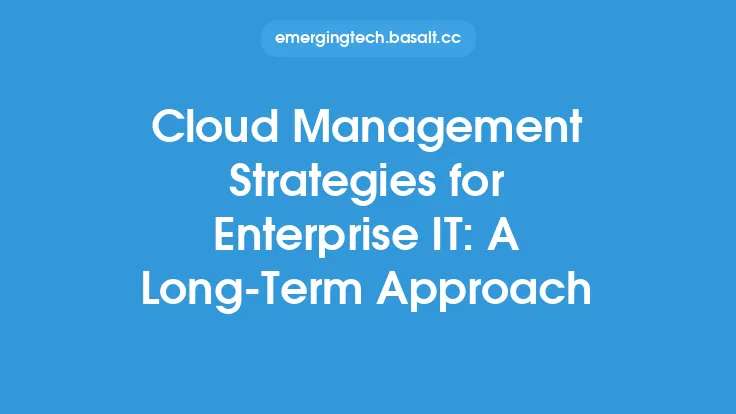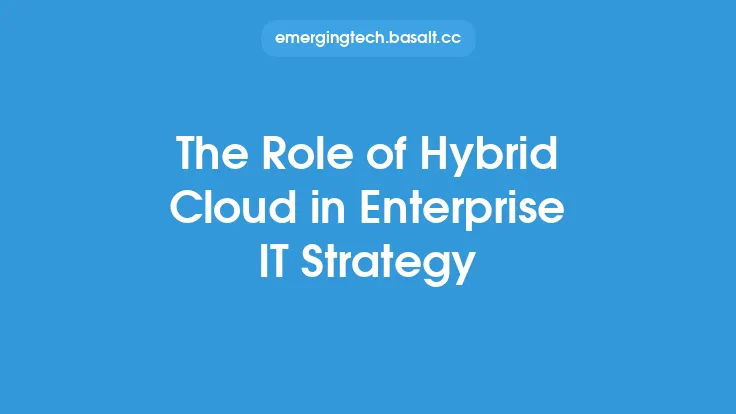Measuring the return on investment (ROI) of cloud migration is a crucial step in determining the success of a cloud migration project. It helps organizations understand the financial benefits of moving their applications and data to the cloud and make informed decisions about future investments. In this article, we will discuss a comprehensive approach to measuring the ROI of cloud migration, including the key metrics to track, the benefits of cloud migration, and the challenges of measuring ROI.
Introduction to Cloud Migration ROI
Cloud migration ROI is a measure of the financial return an organization receives from migrating its applications and data to the cloud. It is calculated by comparing the costs of migrating to the cloud with the benefits received, such as reduced infrastructure costs, increased scalability, and improved agility. Measuring cloud migration ROI is essential to determine whether the investment in cloud migration has paid off and to identify areas for improvement.
Key Metrics to Track
To measure the ROI of cloud migration, organizations need to track several key metrics, including:
- Cost savings: The reduction in infrastructure costs, such as server and storage costs, as a result of migrating to the cloud.
- Increased revenue: The increase in revenue generated by the organization as a result of improved scalability, agility, and reliability of cloud-based applications.
- Improved productivity: The increase in productivity of employees as a result of accessing cloud-based applications and data from anywhere, at any time.
- Reduced downtime: The reduction in downtime and improved uptime of cloud-based applications, resulting in increased customer satisfaction and loyalty.
- Enhanced security: The improvement in security and compliance of cloud-based applications and data, resulting in reduced risk and improved customer trust.
Benefits of Cloud Migration
Cloud migration offers several benefits, including:
- Reduced infrastructure costs: Cloud providers manage the infrastructure, reducing the need for organizations to invest in hardware and maintenance.
- Increased scalability: Cloud-based applications can scale up or down to meet changing business needs, reducing the need for expensive hardware upgrades.
- Improved agility: Cloud-based applications can be deployed quickly, reducing the time and cost of developing and deploying new applications.
- Enhanced collaboration: Cloud-based applications enable employees to collaborate more effectively, regardless of location or device.
- Improved disaster recovery: Cloud providers offer built-in disaster recovery and business continuity capabilities, reducing the risk of data loss and downtime.
Challenges of Measuring ROI
Measuring the ROI of cloud migration can be challenging, due to several factors, including:
- Difficulty in estimating costs: Estimating the costs of cloud migration, such as the cost of re-architecting applications and training employees, can be difficult.
- Intangible benefits: Some benefits of cloud migration, such as improved agility and collaboration, can be intangible and difficult to quantify.
- Complexity of cloud pricing models: Cloud pricing models can be complex, making it difficult to estimate costs and measure ROI.
- Limited visibility into cloud costs: Organizations may not have visibility into cloud costs, making it difficult to track and measure ROI.
Best Practices for Measuring ROI
To overcome the challenges of measuring ROI, organizations can follow several best practices, including:
- Establish clear goals and objectives: Establish clear goals and objectives for cloud migration, including the metrics to track and the benefits to achieve.
- Develop a comprehensive cost model: Develop a comprehensive cost model that includes all the costs associated with cloud migration, such as infrastructure costs, labor costs, and training costs.
- Use cloud cost management tools: Use cloud cost management tools to track and manage cloud costs, providing visibility into cloud spending and enabling organizations to optimize costs.
- Monitor and report on ROI: Monitor and report on ROI regularly, using metrics such as cost savings, increased revenue, and improved productivity.
Tools and Techniques for Measuring ROI
Several tools and techniques are available to help organizations measure the ROI of cloud migration, including:
- Cloud cost management tools: Tools such as AWS Cost Explorer, Azure Cost Estimator, and Google Cloud Cost Estimator provide visibility into cloud costs and enable organizations to optimize costs.
- ROI calculators: ROI calculators, such as the Cloud ROI Calculator, provide a simple and easy-to-use way to estimate the ROI of cloud migration.
- Cloud migration assessment tools: Tools such as the Cloud Migration Assessment Tool provide a comprehensive assessment of an organization's readiness for cloud migration and estimate the costs and benefits of migration.
Conclusion
Measuring the ROI of cloud migration is a critical step in determining the success of a cloud migration project. By tracking key metrics, understanding the benefits of cloud migration, and overcoming the challenges of measuring ROI, organizations can make informed decisions about future investments and optimize their cloud spending. By following best practices, using cloud cost management tools, and leveraging ROI calculators and assessment tools, organizations can ensure a successful cloud migration and achieve a strong ROI.





